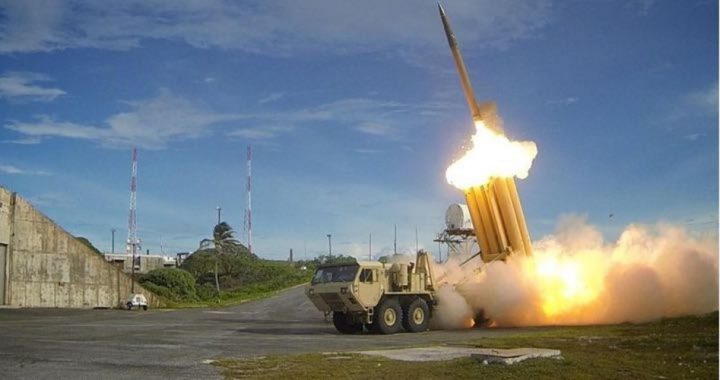
The U.S. Missile Defense Agency (MDA) announced on July 11 that our military had conducted a successful test of the THAAD, or Terminal High Altitude Area Defense anti-missile system. A THAAD interceptor was launched from the Pacific Spaceport Complex in Kodiak, Alaska, and intercepted a target missile launched from an Air Force Cargo plane north of Hawaii.
“The successful demonstration of Thaad against an IRBM-range missile threat [intermediate-range ballisitc missile] bolsters the country’s defensive capability against developing missile threats in North Korea and other countries,” the MDA statement said.
“I couldn’t be more proud of the government and contractor team who executed this flight test today,” MDA Director Lt. Gen. Sam Greaves said in the statement. “This test further demonstrates the capabilities of the THAAD weapon system and its ability to intercept and destroy ballistic missile threats.”
A Defense Department official was cited by CNN as explaining that this latest test is not related to North Korea’s July 4 intercontinental ballistic missile (ICBM) launch, presumably because the THAAD is not designed to intercept an ICBM.
THAAD is designed to shoot down short, medium, and intermediate-range ballistic missiles that have shorter ranges than the ICBM that North Korea launched in July.
Lockheed Martin, in a report carried by Business Insider, also said that THAAD could intercept incoming missiles both inside and outside the Earth’s atmosphere.
The ground-based THAAD system has hit its target in all 14 intercept attempts since testing began more than a decade ago, but the latest test was the first ever success against an IRBM, according to U.S. officials cited by the BBC. The United States has installed THAAD systems in Guam, Hawaii, and South Korea. Earlier this month, Moscow and Beijing, in a joint statement, called on the United States to immediately halt deployment of THAAD in South Korea, charging that Washington was using North Korea as a pretext to expand its military presence in Asia, a move that risks upsetting the strategic balance of power in the region.
A July 11 report in Business Insider noted that THAAD’s success rate in testing is far higher than the one for the U.S. military’s Ground-based Midcourse Defense system (GMD), which is designed to shoot down an ICBM headed for the U.S. mainland.
The GMD system has only a 55-percent success rate over the life of the program. However, advocates say the technology has improved dramatically in recent years.
We noted in our June 1 article that the U.S. Missile Defense Agency, in cooperation with the U.S. Air Force 30th Space Wing, had successfully tested a GMD system on May 30. In that test, GMD launched from Vandenberg Air Force Base in California intercepted an ICBM-class target launched from Kwajalein Atoll in the Republic of the Marshall Islands.
“The intercept of a complex, threat-representative ICBM target is an incredible accomplishment for the GMD system and a critical milestone for this program,” MDA Director Vice Admiral James Syring said in a statement quoted by Defense News. “This system is vitally important to the defense of our homeland, and this test demonstrates that we have a capable, credible deterrent against a very real threat.”
Jen Judson, the land warfare reporter at Defense News, noted in her May 30 article that the test was the first time the GMD system was used against an ICBM-class target, although some previous tests have featured intermediate-range ballistic missile targets that have approached ICBM speeds. Judson quoted Tom Karako, a missile-defense analyst at the Center for Strategic and International Studies, who told her: “This is an important day for homeland missile defense. Hit-to-kill has once again been validated, and this time against an ICBM. The Missile Defense Agency has been on a long road to improve the reliability and capability of the GBI fleet. Details are still coming in, but today’s test promises good things for the defense of the nation.”
We observed in our report that we were encouraged by the successful May 30 test, as we are with the latest successful test of THAAD. Our government’s responsibility under Article IV, Section 4 of the Constitution includes protecting the states again invasion. Perhaps if we spent less money on unconstitutional operations such as defending the rest of the world against invasion, our military would have sufficient resources, such as GMD and THAAD and a lean and ready-to-roll military, to protect our own nation.
Photo of THAAD test: U.S. Army via Wikipedia
Related articles:
North Korea Claims Successful Intercontinental Ballistic Missile Test
U.S. Satellites Detect Activity at N. Korean Nuclear Test Site; U.S. Seeks China’s Help
Aircraft Carriers Gather Off N. Korea; Pyongyang Tests Missile Able to Hit Ships
In Test That Will Send Message to N. Korea, U.S. Successfully Intercepts ICBM
N. Korea Continues Missile Tests; U.S. Moves 3rd Carrier Strike Force to Western Pacific
North Korea Tests Another Missile, Says They Are Ready to Deploy
North Korea Tests Ballistic Missile Capable of Reaching U.S. Base on Guam
North Korea Threatens U.S. With “All Out War” and “Weekly Missile Tests”
North Korea’s Letter to Congress Says Pyongyang to Speed Up Nuke Program in Response to Sanctions



